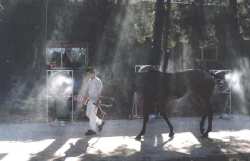|
Physiological basements
1. The horse as a Chemical Machine
The body temperature of a horse must be
into a narrow range (37,5 -38,5 ÂșC) by regulating heat production and heat loss.
The process to convert stored chemical energy
into mechanical energy during exercise is relatively inefficient. Almost 80 percent of the energy released from energy stores is lost as heat.
All the complex neurophysiological mechanisms
that take place in heat dissipation, are carried out by the thermoregulatory system of the horse, which is essential for the develop of any athletic discipline, like high goal polo.
There are four mechanisms of heat dissipation in the horse: radiation, convection, conduction and evaporation. But the most important of this four is the sweat evaporation.
 2. Evaporation 2. Evaporation
The conversion of water from liquid to vapor is an endothermic process (needs energy to be done). Thus evaporation of water at the surface of the body results in heat loss.
The cardiovascular system has a role in
thermoregulation, blood flow being used as a means for heat transfer from sites of heat production to areas where dissipation of heat can occur, primarily the skin.
3. The Environment
In order to dissipate the heat produced  by seven minutes of maximal exercise (polo
chukker), a large amount of sweat would be required for evaporation. by seven minutes of maximal exercise (polo
chukker), a large amount of sweat would be required for evaporation.
The amount of heat loss by evaporation of sweat, will depend of the environment conditions like: temperature, relative humidity, wind
velocity, and sun radiation.
Horses like humans, are very sensitive to external temperature. If you compare the resistance in a hot environment between a horse and a camel, in a one day exposition at a
sunny summer day in the Sahara Desert, the camel might lose 1% of his body weight in water evaporation, and a horse 7%.
This has an explanation and itâs because the camels normal body temperature range is six
times wider than the horse range. (camels body temperature: 34,2 - 40,7 ÂșC). Thatâs why a camel can survive in the desert and a horse not.
As the ambient temperature increases, the skin-environmental temperature gradient falls, becoming negligible at about 36ÂșC, and actually reversing at higher environmental
temperatures. When skin temperature and ambient temperature are equal, sweat evaporating mechanism becomes the only avenue for dissipation of heat.
 The rate of heat loss by evaporation of sweat depends mainly on the water vapor pressure gradient between the skin and the environment and the fraction of the
body surface area that is covered with sweat. High environmental humidity will decrease the water vapor pressure gradient and limit the ability of the body to lose heat via sweating. The rate of heat loss by evaporation of sweat depends mainly on the water vapor pressure gradient between the skin and the environment and the fraction of the
body surface area that is covered with sweat. High environmental humidity will decrease the water vapor pressure gradient and limit the ability of the body to lose heat via sweating.
The environmental conditions of high
ambient temperature and humidity presents a serious threat to the bodyâs mechanisms of heat loss and can result in risky elevations of body temperature if exercise continues.
A horse can loose 10 liters of sweat playing a chukker in a hot environment.The effects in a horse that plays high goal polo in adverse environment conditions (high temperature,
high humidity, high sun radiation and no wind ), can end in dehydration and dangerous electrolyte loses, that can compromise the horse future accomplishments.
(*) Heart Rate vs. Recovery Time
(*) Horse Performance Survey - Palermo Open 1997 to 1999
This chart repersents the different Recovery Time of the average horse using the Equine Recovery
System® after playing a complete chucker at The Argentine Open Polo Championship.
As seen, after 15 minutes the horse is recovered to play another chucker.
|